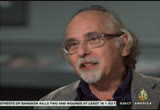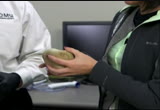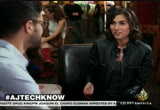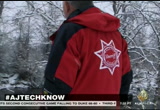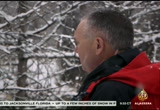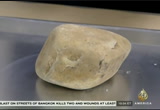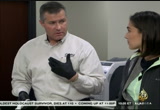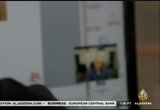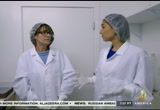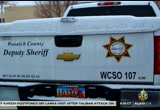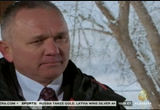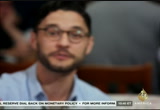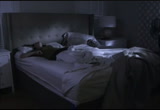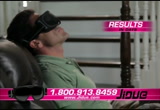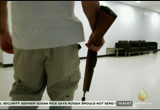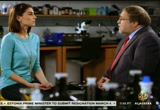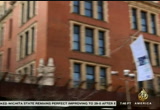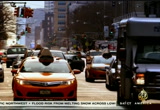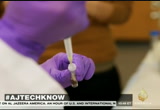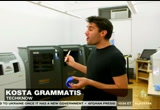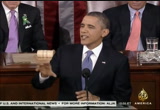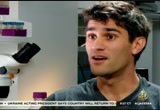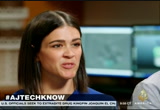tv Tech Know Al Jazeera February 23, 2014 10:30pm-11:01pm EST
10:30 pm
comics and i'm still not well equipped to do it. >> i would disagree. >> i know what i can do. >> i look forward to seeing more of your work. thank you thank you very much. >> thank you. >> hello and welcome. i'm phil torres here to talk about innovations that can change lives. we're going to explore the intersection of hardware and humanity and doing it in a unique way. this is a show about science by scientists. let's check out our team of hard core nerds. >> dr. crystal dilworth is a molecular neuroscientist. a young woman murdered, a trail that went cold after 19 years. tonight it's the real csi, solving crimes hike never before. kosta grammatis, is a scientist,
10:31 pm
tonight he shows us everything you need to know about 3d printing. i'm phil torres, i'm an entomologist exploring spiders in the rain forests of peru. that's our team. ow let's do some science. ♪ ♪ ♪ >> hey guys i'm phil torres, whom to "techknow" and i'm here with kosta and crystal, your story has the mystery of a scientist and tell me about it. >> i was looking at how new kinds techniques
10:32 pm
can influence the crime fighting. take a look. >> high speed cameras. >> cross light on it, then you can spot them back here. >> new ways to match dna. >> stem back without contaminating any of the evidence. >> 3d models. evidence invisible to the naked eye. the crime-fighting of the future is here today. we begin our story about an hour southeast of salt lake city. we're near midway, utah. this is wasatch county along the banks of the provo river. schaeffer knows the river well memories. >> i was a sheriff, you never expect a call such as that. minutes.
10:33 pm
>> it was a december morning in 1995 when then deputy todd boner. was called to the banks of the river. it was a real life whodonit. cold. there are very few murders in wasatch county. >> probably one of the artest cases i've ever had to deal with in my life. >> back in 1995. crystal's mother said she left the area and started working as a prostitute. but bonner was determined to get her justice. >> there hasn't been a day gone by that i hadn't thought about her, and the suspect was out there possibly hurting someone else.
10:34 pm
>> bon ner couldn't catch any breaks. >> we didn't have the technology to move forward with the dna. >> for more than 15 years the case was cold. but finally, thanks to new technology, schaeffe sheriff bonner caught his break. >> i learned about touch dna. wanted to come up with something. >> he assigned the case to brian gardner. >> with the advent of touch dna possibly we could test and get a dna match. >> she was killed with a rock like this one. at the time they didn't have the technology to recover dna for through. >> i was really surprised. >> so how do you get dna from a rock? >> jarrod bradley has the answer.
10:35 pm
he is a president of a company called m-back system. his company made the vacuum that extracted the dna from that rock. >> this system enables the investigators to get into any kind of rough surface like rock and concrete where the dpa is -- dna is not going to be on the surface or available. >> the rock has little holes on it, you're not going to get it. but you are using a vacuum technique. >> it sprays and literally conducting a hurry cak hurricane for the dna material. if i was the suspect and i grabbed somebody like this i've transferred my dna. >> in which case, they got some dna samples from a rock. >> this is a typical utah river rock. if this were to be used as a murder weapon the suspect is
10:36 pm
going to leave touch dna, skin cells and sweat and that kind of rock. if you can't see it with the faked eye, those are the perfect -- naked eye those are the perfect samples for the m-vac system. >> the samples get sent back to the lab. here in the colorado rockies are one of the most unique models in the world. scientists are bringing, to the dna analysis. analysis. >> of course the big problem here is that we have a lot of the blood of the victim pressed. >> they run independent forensic service out of their home laboratory, often teleconferencing with their home in the netherlands.
10:37 pm
>> she didn't have much wiggle room. >> they have worked on the highest profile cases in the decade, includes casey thont. casey anthony. their ultimate goal is truth-finding. >> getting the perpetrator behind bars. >> it's awful to live with a crime somebody had committed to a loved one and not knowing what happened. >> touch dna comes in the outer layers of skin cells. when you touch someone with force, those cells shed. force, the more dna left behind. >> much smaller amounts of dna than 15 years ago. >> how does that process start? >> we start by sterilizing all our equipment. >> they put their equipment in an ultrasonic bath then another one then maximum heat and seal
10:38 pm
it in a sterile bag. >> richard is looking for any irregularities that he can see on the surface. looking for traces of blood or sperm or other bodily fluids. there's a reasonable chance that we can find dna here. >> besides murder cases, touch dna is now used in sexual assault cases. >> for instance, a suspect who said he had contact with the person but did not rape. stored in these locations. >> once they identified the areas they want to test they analyze it like regularly dna. >> the dna profile is very informative. that person has some explaining to do if it's not a husband. >> back in utah the dna extraction worked and investigators have a match through touch dna. >> suspect's name is joseph michael simpson. he had been a resident in utah
10:39 pm
back in the '80s, early '90s, moved to florida and been there ever since. >> simpson spent time in the utah state prison for murder in the 1980s. >> why did you test? >> she was a young girl, you look on it like she's one of your own. i would expect law enforcement to do everything they can to find justice. i owed it to the parents. >> did you make the phone call to crystal's parents to let them know they could have closure? >> it was a very, very satisfying one, one that -- one i will treasure for a long time. it was very rewarding. to say the least. >> i'm just amazed at the faculty that they could vacuum
10:40 pm
up river rocks and find dna on it. >> right, the resolution of these new technologies allows us to get usable information of just a few cells as you saw. and lets us solve crimes or at least get evidence for. >> the improper handling of dna evidence is this going to be another problem? >> right the technology doesn't exist in a vacuum right? we were relying on the technicians that investigate the crime scene and do the analysis not contaminating it. that's a huge issue. >> what do you have next? >> i took a look at the john jay college and the techniques they come up with. >> we'll take that up after the break. >> join the conversation following us on twitter
10:41 pm
>> start with one issue education... gun control... the gap between rich and poor... job creation... climate change... tax policy... the economy... iran... healthcare... ad guests on all sides of the debate. >> this is a right we should all have... >> it's just the way it is... >> there's something seriously wrong... >> there's been acrimony... >> the conservative ideal... >> it's an urgent need... and a host willing to ask the tough questions >> how do you explain it to yourself? and you'll get... the inside story ray suarez hosts inside story weekdays at 5 eastern only on al jazeera america >> i'm joie chen, i'm the host of america tonight, we're revolutionary because we're going back to doing best of storytelling. we have an ouportunity to really reach out and really talk to voices that we haven't heard before... i think al jazeera america is a watershed moment for american journalism
10:43 pm
10:44 pm
area of crime scene investigations are really changing the field. what comes up next? >> i got a chance to geek out. how to crime scene investigations in five, ten, even 20 years. pretty exciting, check it out. ♪ >> i'm here in the art of new york city. at john jay college where they train the best of the best of tomorrow's crime scene investigators. professors here are at the cutting edge of forensic technology to help them stay one step ahead of the criminals. at this campus these men are rock stars. they created many of the technologies either used today or soon to be used in the future. cameras, animation, and new industry.
10:45 pm
>> this is a mock crime scene. you can look into this scene and come to some conclusions. and one of the first things that we need to do is to determine whether they're alive or not. >> lawrence kobelinski is the head of this program. >> we want our students to develop the skills and knowledge that will make them good forensic scientists. we have to process the scene. go around the scene again in a spiral pattern. we've identified all the physical evidence. we need to now package it, document it. and get it to the lab. what we're looking for is a linkage between the suspect, and the victim, or between the suspect and the crime scene. the best ways of course are fingerprints and dna analysis. >> but nowadays, crime scene analysts have to rely on
10:46 pm
something else. >> how does that occur? >> today, things we do weren't even thought about years ago. we can bring instrumentation into the crime scene and not only collect evidence but start to analyze it. camera. >> what happened at the crime scene? okay. you can see the body. on the bed. you can see there's a monkey wrench on that edge of the bed. >> it gives investigators and injuries another perspective. and allows -- and juries to reenter the crime scene long after it's been cleared. >> laeah is going to fire at the piece of glass and going to assess the dynamics of the bullet with the
10:47 pm
glass. 10 ,000 -- >> light, clear. >> wow, what type of information are we going to be getting from that? >> he's going to see the bullet approach the glass in air where it's in stable flight. then the stabilization, the bullet is going to be destabilized at that point. >> can you give me a real world example in a crime scene? >> a classic example is if an officer stops someone in a vehicle, if a shooting transpires, who shot first? did the officer shoot first or the person in the vehicle? this is just the tip of the iceberg. >> other biological evidence that can one day solve crime. we
10:48 pm
had him show off his work. >> each of you are going to smell a flower. i'm not going to know which flower that was. we are going to swab your nose and detect which flower you smelled. we can deduce where a person was earlier in the day, by what type of biological evidence they gathered, flower or tree or weed, dander from a pet. i'm going to leave the room, you guys smell your flowers and we see if we can detect which flower. >> here i have a chrysanthemum. we'll detect how good his technology is. we both detected a flower. >> cotton swab, we'll pick up whatever pollen we can from your nostrils. and whatever human dna possible. now she's going to cut off the swab into a solution where we
10:49 pm
extract the dna. what we are doing now is called vor texting. the -- fo vortexing. the tube will release the dna. >> we are back in the lab nearly 24 hours after he swabbed our noses. >> i would say kezia, you sniffed the sunflower am i right? >> yes. good our test found chrysanthemum dna in crystal. did you smell the cri sa chri chrysanthemum? >> yes i did. >> nowadays by probing that dna we with actually learn potential information about the person. once we collect some dna, there's no limit to what we can learn.
10:50 pm
>> as thee crime-fighting techniques are further developed more criminals will be outsmarted . by science and by technology. what is your message to criminals? >> we are going to catch you. we are going to use science and science is getting better and better. so you might as well turn yourself in. >> needless to say we've come a long way from just drawing chalk around a body. it is disconcerting if i just brush up against something they can get my dna. there is a lot can you do. >> volunteering that information will make sure you are implicated in a crime. >> i'm curious how juries can adapt to that. kosta, you tac take a look at 3d printing. >> jewelry heart valves and tasty treats. >> great, we'll take a look at
10:51 pm
so many money stories sound complicated. but don't worry. i'm here to take the fear out of finance. every night on my show i break down the confusing financial speak and make it real. >> al jazeera america is a straight-forward news channel. >> its the most exciting thing to happen to american journalism in decades. >> we believe in digging deep. >> its unbiased, fact-based, in-depth journalism. >> you give them the facts, dispense with the fluff and get straight to the point. >> i'm on the ground every day finding stories that matter to you. >> in new orleans... >> seattle bureau... >> washington... >> detroit... >> chicago... >> nashville... >> los angeles... >> san francisco... >> al jazeera america, take a new look at news.
10:53 pm
take a new look at news. >> ♪ ♪ ♪ >> hey guys welcome back to "techknow." i'm here with kosta and crystal. kosta what do you have for us? >> 3d printing. we went and took a look at all the greatest and latest new technologies, from heart valves to sugary treats, 3d printing on "techknow." from trinkets and 96
10:54 pm
nicknacks, 3d fashion and food, from auto makers prototyping parts, to nasa, printing parts. >> this is absolutely a critical technology. >> and medical solutions. >> we've seen the row bow solution,. >> to life altering research. >> my lab makes ears. it's alive when it goes into the printer, it's alive when it comes out of the printer. >> creating the molds for replacement need to prototyping tv remotes. 3d printers are not anything like your home printer. >> 3d printing is a process that makes physical objects. a 3d principlers spits out droplets on a plate.
10:55 pm
little by little, not making a picture of the coffee cup but the coffee cup itself. every 3d print starts with a file, where to print, where to put the material. hoar is the printed speaker, you can go ahead and make changes. >> that information has been sent to the printer that prints layer after layer, hour after hour. >> what do we have here? >> what we have here is the first entirely 3d printed consumer device, it's a loudspeaker. >> why is this a big innovation? >> moving from passive parts to things that have action, sense, react, do something. >> last year we created our first manufacturing innovation institute in youngstown, ohio. >> earned a shout-out from the president.
10:56 pm
>> revolutionize how we make almost everything. >> across the cornell campus, life savings innovations. >> heart valves are complex geometry shapes. and if we use 3d printing we can duplicate that shape. >> at the biomechanical lab, laura is working on a pediatric valve. >> if you can take stem cells you can fabricate a living valve that would be used as a prosthetic. >> you 3d print a valve using the patient's own stem cells and it will grow with them. good yes, that's the idea. >> if it works, it will be lifesaving for boys like 9-year-old max page, he's that cute darth
10:57 pm
vader character. >> we knew max was in trouble. they discovered he had a congenital heart defet. 2012. >> what was an adequate sized connection between the heart and lungs, at three months of aiming, is not adequate -- of age, is not adequate for a seven and a half year old boy. >> for max the valve is artificial, it won't grow with him. when he gets 18 he'll need a valve to match that size body and when he is a full size valve. >> it makes me happy to know woe have somebody else on our side. >> we talked with a family whose child currently suffering from this condition. and they are so excited about what you're doing. in these technologies are so close to a break through, it might sound off in the distance
10:58 pm
but for us it's our future, it's our reality and it's not just dreaming about kids that might be born today. it's this kid right here. >> across the country, in los angeles, liz and kyle von haslam mix their design know-how with sugar, the sugar lab. >> what the printer does when you hit play, it sprays out a fine layer of sugar and paints basically with water. wherever that model exists at that cross-section and then it spreads another very fine layer of sugar and it paints the next cross section from the very bottom layer of the object to the very top layer until the whole model is built. process. >> then comes the fun part. station. this is where we clean off all the excess sugar that is burying
10:59 pm
the model. >> it's the most delicious air i've ever breathed. >> looks like you annihilated certain sections of it here. >> i have to get rid of these damaged goods. delicious! >> all right kosta, so tell the truth. what did 3d printing taste like? >> delicious and i actually have some 3d printed treats for you guys to try. >> those ar mazing. >> -- those are amazing. >> candy of the future. >> work of art. >> bite in. bite in. >> like a big plump pixie stick. very good. i'd like to know how 3d printing could be incorporated into crime scene investigation. that's right here in the future and we here at "techknow" will be covering it. dive deep into these stories and go behind the scenes
11:00 pm
at aljazeera.com/techknow. and visit us on facebook, google ... this is al jazeera america. i am jonathan betz live in new york. a new path for ukraine, the new interim president meets with the american ambassador and is already promising closer ties with europe. in venzuela, a retired army general turns against the government and rallies support for the opposition. this is the face of a man the u.s. considers a global terrorist. why he says he is only trying to save lives.
210 Views
Uploaded by TV Archive on

 Live Music Archive
Live Music Archive Librivox Free Audio
Librivox Free Audio Metropolitan Museum
Metropolitan Museum Cleveland Museum of Art
Cleveland Museum of Art Internet Arcade
Internet Arcade Console Living Room
Console Living Room Books to Borrow
Books to Borrow Open Library
Open Library TV News
TV News Understanding 9/11
Understanding 9/11